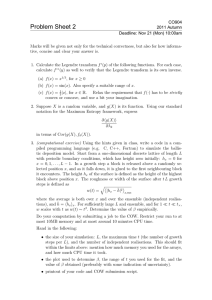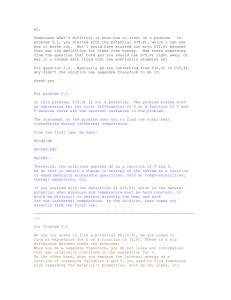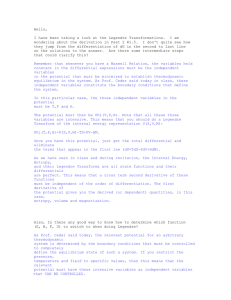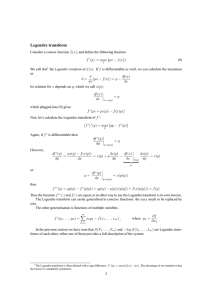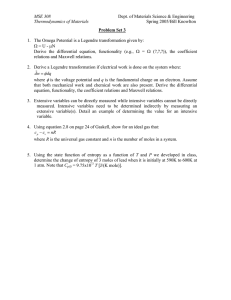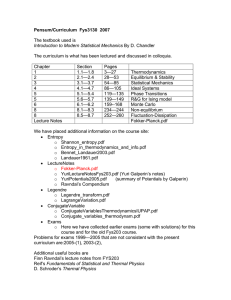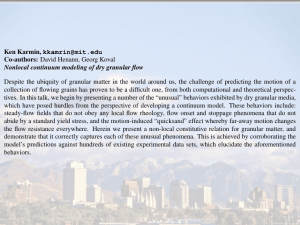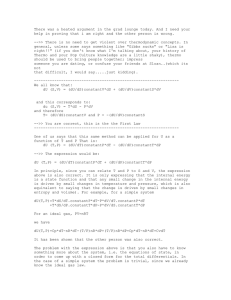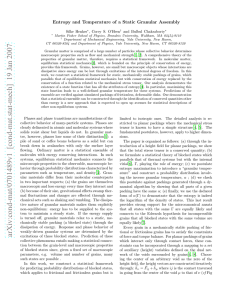PX4390 THE UNIVERSITY OF WARWICK Fourth Year Examinations: Summer 2010
advertisement
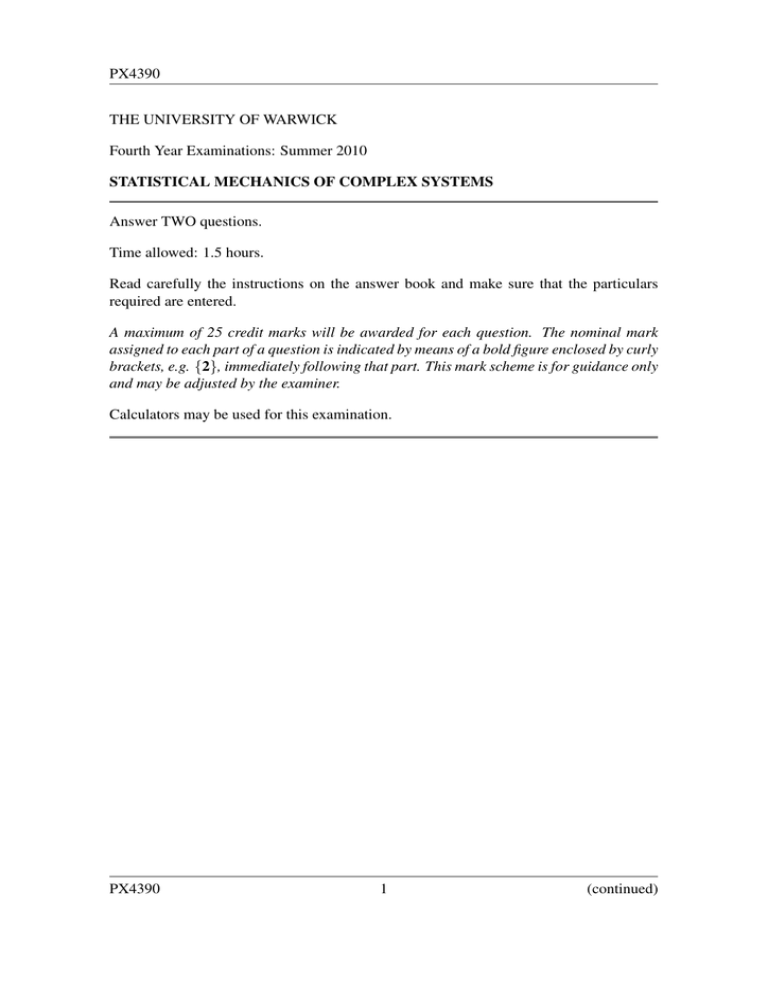
PX4390
THE UNIVERSITY OF WARWICK
Fourth Year Examinations: Summer 2010
STATISTICAL MECHANICS OF COMPLEX SYSTEMS
Answer TWO questions.
Time allowed: 1.5 hours.
Read carefully the instructions on the answer book and make sure that the particulars
required are entered.
A maximum of 25 credit marks will be awarded for each question. The nominal mark
assigned to each part of a question is indicated by means of a bold figure enclosed by curly
brackets, e.g. {2}, immediately following that part. This mark scheme is for guidance only
and may be adjusted by the examiner.
Calculators may be used for this examination.
PX4390
1
(continued)
PX4390
1.
(a) Explain what is meant by thermodynamic limit. What is its connection to statistical mechanics and thermodynamics?
{4}
(b) What is the central limit theorem? Explain the conditions and the type of convergence involved.
{4}
(c) An ant is trying to climb a hill. In every second it either tries to move (with
probability 1/2), or rests (probability 1/2). If it tries to move, during one second
it either succeeds progressing 1 cm (with probability 7/8), or falls back 3 cm
(probability 1/8). The above possibilities happen every second independently.
(i)
On average how much does the ant progress in one second? What is its
variance?
{4}
(ii) Suppose the ant progresses distance X3600 in one hour. What is the expected value of X3600 ? What is the approximate distribution, what are its
parameters?
{4}
(iii) Is it likely or unlikely that within one hour the ant has reached the top of
the hill, 7 m ahead? Justify your answer.
{2}
(d) (i) What is a stable distribution?
{3}
(ii) Write down the names and probability density functions (pdfs) of two families of stable distributions in as general form as possible.
{4}
PX4390
2
(continued)
PX4390
2.
(a) (i)
(ii)
In the context of granular packing, explain the difference between the angle of repose and the maximum angle of stability (sometimes called angle
of maximum stability). Which one is larger?
{4}
wind
α
β
The figure above shows the schematic cross section of a certain (“barchan”)
moving sand dune. (Note: the angles on the figure are not to scale.) The
side facing the wind has no avalanches despite the wind driving surface
grains to move; its slope is denoted by α. The other side, pointing in the
opposite direction, has frequent avalanches and its slope is β. What relationships do the slopes α and β have to the angle of repose and maximum
angle of stability?
{3}
(b) (i) Explain what is meant by granular segregation.
(ii) Describe in detail an experiment exhibiting granular segregation.
(iii) Give one possible mechanism driving granular segregation.
{3}
{3}
{2}
(c) (i) Define the Edwards ensemble of granular packings.
{2}
(ii) Let Vi denote the volume of state i of the packing. Write down the partition
function and the probability of each state using the Maximum Entropy formalism. (By convention the Lagrange multiplier is denoted by 1/(kE X),
where X is the “compactivity”.)
{4}
(iii) In a very simple abstract model, each granular particle independently can
be in three different states: occupying either volume v0 , v1 or v2 , with
v0 < v1 < v2 . The total volume of the packing of N particles is simply
the sum of the particles’ volumes. In the Edwards ensemble of this model,
what is the possible minimum and maximum achievable ensemble average
volume of the packing, and what are the corresponding compactivities?
(You do not need to do detailed calculations.)
{4}
PX4390
3
(continued)
PX4390
3.
Suppose f (x) is a convex function. What is the Legendre transform of
f (x)? In your answer consider the general case when f (x) is not differentiable, as well as the implications when f (x) is differentiable.
{4}
(ii) What is the inverse of the Legendre transform for convex functions? {2}
(iii) Calculate the Legendre transform of f (x) = x4 .
{4}
(a) (i)
(b) In the general form of the Maximum Entropy framework the partition function
of a random variable X with constraints hfk (X)i = Fk (k = 1, . . . , m) can be
written as
!
n
m
X
X
Z(λ1 , . . . , λm ) =
exp −
λk fk (xi )
i=1
k=1
(i) Explain all symbols in the equation above.
{2}
(ii) Write down the probability of the ith state using the above formalism. Using these probabilities, calculate the information entropy. Show that the
information entropy is the Legendre transform of − ln Z.
{4}
(iii) Express hfk (X)i using derivatives of Z.
{3}
(iv) Derive reciprocity relations, i.e. relations between quantities of the form
∂hfk (X)i/∂λj .
{2}
(v) Define the variance of a random variable A, and express the variance of
fj (X) in terms of derivatives of Z. Justify that the Legendre transform of
− ln Z is indeed well defined.
{4}
PX4390
4
(End)
